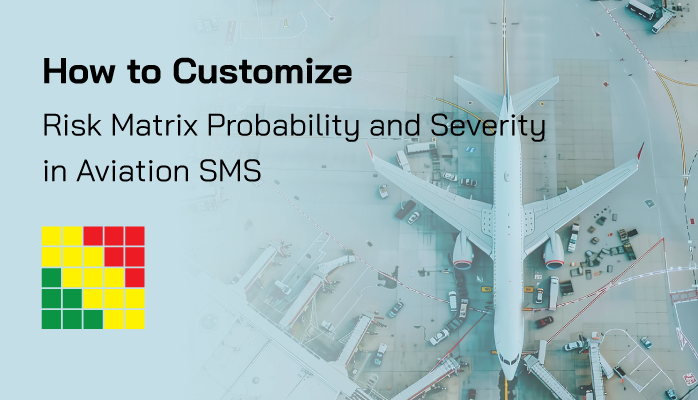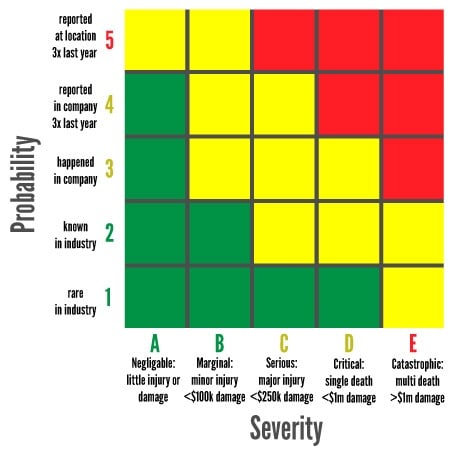Risk Matrix Probability and Severity in Aviation SMS

Every aviation safety manager is familiar with the risk matrix, particularly the 5x5 model. Risk matrices are a vital tool in aviation safety management systems (SMS), enabling organizations to assess and prioritize risks by combining their probability and severity.
This comprehensive guide outlines how aviation safety managers can define these criteria to customize an effective, organization-specific risk matrix to be used in their aviation SMS.
Key Points for Defining Risk Matrix Probability and Severity in Aviation Safety
- Risk Matrix Overview: A risk matrix is a critical tool in aviation safety management, helping to assess and prioritize risks by combining their probability (likelihood of occurrence) and severity (potential impact).
- Probability Definition: Probability levels, such as Frequent to Extremely Improbable, can be set using historical data or expert judgment, tailored to an organization’s operations.
- Severity Definition: Severity levels, ranging from Negligible to Catastrophic, should reflect potential consequences like safety, financial, or operational impacts, customized to the organization’s context.
- Customization is Key: Effective risk matrices are organization-specific, accounting for factors like size, location, and operational challenges, such as Alaska’s unique weather conditions.
- Best Practices: Involve stakeholders, use clear criteria, and regularly review the matrix to ensure it remains relevant and effective.
What Is a Risk Matrix?
A risk matrix is a visual tool used in aviation safety to evaluate risks by plotting their likelihood against their potential impact. It helps safety managers decide which risks need immediate action and which can be monitored. According to the International Civil Aviation Organization (ICAO), risk matrices are standard in safety management systems (SMS) for assessing hazards in a structured way.
Related Articles on ICAO Mandated SMS
- What Is ICAO's Role in Aviation Safety Management Systems?
- Setting Up an Aviation Safety Management System (SMS)
- QMS Programs vs Aviation Safety Management Systems (SMS)
Why Define Probability and Severity?
Defining probability and severity ensures that risk assessments are consistent and meaningful. Probability indicates how likely a hazard is to occur, while severity measures the potential harm if it does. Clear definitions make the matrix a reliable decision-making tool.
How to Approach Customization?
Every aviation organization is unique, so the risk matrix must reflect specific operational realities. For example, in Alaska, where weather-related incidents are more common, probability levels might be adjusted to account for frequent adverse conditions. The FAA’s Alaska Aviation Safety Initiative highlights the need for tailored risk management in such environments. Engage experts and stakeholders to set criteria that align with your organization’s goals and regulatory requirements.
Where to Start?
Begin by adopting a standard framework, like the 5x5 matrix from ICAO, which uses five probability and severity levels. Then, customize these levels based on your data and operational context. Regularly test and update the matrix to keep it effective, as recommended by the FAA Advisory Circular 120-92.
Comprehensive Guide to Defining Risk Matrix Probability and Severity
A well-defined risk matrix is the cornerstone of effective aviation safety management. By systematically evaluating the probability and severity of potential hazards, safety managers can
- prioritize risks,
- allocate resources efficiently, and
- enhance overall safety.
This guide provides a detailed roadmap for aviation safety managers to define probability and severity criteria for a risk matrix, ensuring it is tailored to their organization’s unique needs. Drawing from authoritative sources like the International Civil Aviation Organization (ICAO) and the Federal Aviation Administration (FAA), this article offers practical steps, examples, and best practices to create an impactful and evergreen risk matrix.
Related Risk Matrix Articles for Aviation SMS
- What Is a Risk Matrix and Risk Assessment in Aviation SMS
- How to Create Your Risk Matrix for Risk Assessments in Aviation SMS
- 5 Questions to Ask Before Making Risk Assessment
Introduction to the Risk Matrix in Aviation Safety

In aviation, where safety is prioritized by necessity, a risk matrix serves as a critical tool within safety management systems (SMS). It is a grid that combines the likelihood (probability) of a hazard occurring with the potential impact (severity) of its consequences. The resulting risk level—often color-coded as green (acceptable), yellow (acceptable with mitigation), or red (unacceptable)—guides decision-making.
According to the ICAO Safety Management Manual (Doc 9859), risk matrices are ubiquitous in aviation SMS, enabling organizations to quantify and prioritize risks systematically. For aviation safety managers, defining clear probability and severity criteria is essential to ensure the matrix is both intuitive and effective.
Understanding Probability in a Risk Matrix
What is Probability?
Probability refers to the likelihood that a hazard will result in an adverse event. In a risk matrix, probability is typically categorized into levels to simplify assessments. The ICAO Safety Management Manual provides a standard 5-level scale:
| Probability Level | Description | ICAO Definition |
|---|---|---|
| Frequent (5) | Likely to occur many times | Has occurred frequently |
| Occasional (4) | Likely to occur sometimes | Has occurred infrequently |
| Remote (3) | Unlikely but possible | Has occurred rarely |
| Improbable (2) | Very unlikely to occur | Not known to have occurred |
| Extremely Improbable (1) | Almost inconceivable | Almost inconceivable that the event will occur |
How to Define Probability Criteria
To define probability levels, organizations can use quantitative or qualitative approaches, depending on available data. Quantitative methods rely on historical data, such as the number of incidents per flight hour or operation. For example, a small Alaskan air taxi operator might define “Frequent” as more than 10 weather-related incidents per year, given the region’s challenging conditions, as noted in the FAA’s Alaska Aviation Safety Initiative. Qualitative methods, useful when data is limited, rely on expert judgment and descriptive terms like “likely” or “rare.”
To set probability criteria:
- Analyze Historical Data: Review incident reports, safety audits, and industry benchmarks to estimate frequencies. For instance, if runway incursions occur once per 10,000 operations, this might be classified as “Remote.”
- Consult Experts: Engage pilots, engineers, and safety officers to validate likelihood estimates, especially for new or rare hazards.
- Consider Local Factors: In regions like Alaska, where adverse weather is common, adjust probability thresholds to reflect higher likelihoods of certain events, as highlighted by the CDC’s Alaska Aviation Safety page.
- Document Clearly: Ensure each level has a clear definition, such as “Frequent: More than 5 occurrences per year” or “Improbable: Less than 1 occurrence in 10 years.”
Understanding Severity in a Risk Matrix
What is Severity?
Severity measures the potential impact of a hazard if it occurs, considering consequences like safety, financial loss, environmental damage, or operational disruption. The ICAO Safety Management Manual outlines five severity levels:
| Severity Level | Description | ICAO Definition |
|---|---|---|
| Catastrophic (A) | Multiple deaths, equipment destroyed | Multiple deaths and/or destruction of equipment |
| Hazardous (B) | Serious injury, major equipment damage | Large reduction in safety margins, serious injury |
| Major (C) | Injury to persons, serious incident | Significant reduction in safety margins, injury |
| Minor (D) | Minor incident, operating limitations | Nuisance, use of emergency procedures |
| Negligible (E) | Few consequences | Little consequences |
How to Define Severity Criteria
Severity criteria should reflect the organization’s operational context and risk tolerance. For example, a small aviation company might consider a $1 million loss catastrophic, while a large airline might classify it as major. SMS Pro's configurable risk matrix follows best practices and allows using multiple consequence categories, such as:
- Personnel Injury: From no injury (Negligible) to multiple fatalities (Catastrophic).
- Financial Damage: From less than $10,000 (Negligible) to over $10 million (Catastrophic).
- Environmental Impact: From slight/no effect (Negligible) to multiple environments affected (Catastrophic).
- Operational Disruption: From no effect (Negligible) to multiple missions affected (Catastrophic).
To define severity criteria:
- Identify Consequence Categories: Determine which impacts are relevant, such as safety, financial, environmental, or reputational.
- Set Thresholds: Assign specific outcomes to each severity level. For personnel injury, “Minor” might mean first aid, while “Hazardous” could mean permanent disability.
- Account for Context: In remote areas like Alaska, where emergency response may be delayed, severity levels might be escalated, as noted in the US Department of Transportation’s Aviation Safety in Alaska.
- Use Multiple Criteria: Combine categories to ensure comprehensive assessments. The highest severity across categories typically determines the overall level.
Related Risk Assessment Articles
- How to Justify Severity of Risk Assessments - Best Practices
- How to Be Compliant With ICAO Safety Risk Assessment and Mitigation
- How to Perform Risk Assessments Without Aviation Risk Management Software
Customizing the Risk Matrix for Your Organization
A generic risk matrix may not suit every organization. Customization ensures the matrix reflects specific risks and operational realities. For instance, Alaskan operators face unique challenges like controlled flight into terrain (CFIT), which accounts for many fatal crashes, per the CDC’s Alaska Aviation Safety page. A tailored matrix might assign higher probability to weather-related risks and higher severity to incidents in remote areas.
Steps to Customize the Risk Matrix
- Determine Scope: Decide which risks the matrix will cover (e.g., safety, operational, financial).
- Define Levels: Use the ICAO 5x5 framework as a starting point, adjusting probability and severity definitions based on data and context.
- Create the Matrix: Construct a grid with probability (1-5) on one axis and severity (A-E) on the other. Assign risk levels (e.g., low, medium, high) and colors (green, yellow, red) to indicate acceptability.
- Set Acceptance Criteria: Define actions for each risk level, such as immediate mitigation for red zones, per the FAA Advisory Circular 120-92.
- Validate and Test: Apply the matrix to past incidents to ensure it accurately reflects risk priorities. Adjust as needed.
- Engage Stakeholders: Involve pilots, maintenance crews, and management to ensure buy-in and relevance.
- Document and Train: Clearly document the matrix and train staff on its use to ensure consistent application.
Examples and Case Studies

Example: Canadian Air Taxi Operator
Consider a small air taxi operator in northern Alberta assessing the risk of flying in marginal weather. Using a customized risk matrix, they define “Occasional” (4) as weather-related incidents occurring 1-5 times per year, given northern Alberta's frequent storms. Severity is set as “Hazardous” (B) due to potential serious injury in remote areas with delayed rescue. The resulting risk index (4B) falls in the red zone, prompting the operator to implement stricter weather minimums or delay flights, aligning with recommendations from the FAA’s Alaska Aviation Safety Initiative.
Case Study: Large Airline
A major airline might define “Catastrophic” as a crash costing over $50 million and multiple fatalities, while “Negligible” is a minor delay costing less than $50,000. By analyzing historical data, they set “Frequent” as more than 10 minor incidents per year. This tailored matrix helps prioritize risks like engine failures over less critical issues like cabin equipment malfunctions, as outlined in the SKYbrary Risk Assessment Matrix Samples.
Best Practices for Defining and Using the Risk Matrix
- Use Clear Definitions: Ensure probability and severity criteria are specific and measurable to avoid ambiguity.
- Leverage Data: Base criteria on incident reports, safety audits, and industry benchmarks for accuracy.
- Involve Experts: Collaborate with operational and safety teams to validate criteria.
- Regularly Review: Update the matrix as operations evolve or new data emerges, as recommended by the ICAO Safety Management Manual.
- Integrate with SMS: Embed the matrix in hazard identification and risk management processes, as seen in the Medallion Five Star Shield program.
- Communicate and Train: Ensure all staff understand and can apply the matrix consistently.
Common Pitfalls to Avoid
- Using Generic Criteria: Adopting a standard matrix without customization can misrepresent risks, especially in unique environments like Alaska or seaplane operations in the Maldives.
- Ignoring Stakeholder Input: Failing to involve operational teams can lead to impractical criteria.
- Static Matrices: Not updating the matrix can render it obsolete as risks evolve.
- Overcomplicating Definitions: Overly complex criteria can confuse users and hinder assessments.
- Neglecting Training: Without proper training, staff may misapply the matrix, reducing its effectiveness.
Related Aviation SMS Training Articles
- When Employees Need More Hazard Identification Training - Aviation SMS
- What Is Aviation Safety Training in Aviation SMS - Includes Videos to Use
- How to Automate Aviation SMS Training in 4 Steps Using Your Safety Program
Special Considerations for Unique Operations
As an example, Alaska’s aviation environment presents unique challenges, including
- frequent adverse weather,
- remote operations, and
- limited emergency access.
The CDC’s Alaska Aviation Safety page notes that over one-third of U.S. air taxi and commuter accidents occur in Alaska, often due to CFIT. Safety managers should:
- Adjust Probability: Increase likelihood thresholds for weather-related risks, as they are more frequent.
- Escalate Severity: Account for delayed emergency response in remote areas, which can worsen outcomes.
- Incorporate Local Data: Use Alaska-specific incident data to inform criteria, as supported by the FAA’s Alaska Aviation Safety Initiative.
Conclusion
Defining probability and severity for a risk matrix is a critical task for aviation safety managers. By adopting a structured approach—using clear criteria, customizing for organizational and regional factors, and following best practices—managers can create a robust tool that enhances safety.
Regular review and stakeholder engagement ensure the matrix remains relevant, while examples like remote Alaskan operations highlight the importance of context. A well-defined risk matrix not only meets regulatory requirements but also fosters a proactive safety culture, ultimately protecting lives and assets in the aviation industry.
Need SMS tools with customizable risk matrix abilities? SMS Pro has this and much more.
Key Citations
- ICAO Safety Management Manual (Doc 9859)
- FAA Advisory Circular 120-92
- Aviation Safety Blog: Defining Severity and Likelihood Criteria
- SKYbrary: Risk Assessment Matrix Samples
- Stakeholder Map: Aviation Safety Risk Matrix Example
- FAA Alaska Aviation Safety Initiative
- US Department of Transportation: Aviation Safety in Alaska
- CDC: Alaska Aviation Safety






